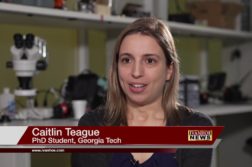SAN ANTONIO, TX (Ivanhoe Newswire) — Schizophrenia is a difficult mental disorder that causes a person to lose touch with reality. Because the symptoms can be so severe, it’s treated with strong drugs, but they have side effects. So, a Texas scientist has unveiled a different approach that may be a game changer.
Daniel Lodge, PhD, Associate Professor at UT Health San Antonio said, “When people hear schizophrenia or psychosis, they immediately go to what they see in movies, the quote,unquote crazy person and that’s not what schizophrenia is.”
Scientists believe schizophrenia starts in utero, but the symptoms, such as hallucinations, paranoia and social withdrawal, don’t appear until a person is in their teens.
Fonda White shared, “Like I was hearing voices. I was seeing things, honestly I thought everybody heard voices.”
He saw dark, shadowy figures, scary to a small child. In many ways, it was like a horror movie. Now he’s a peer specialist taking meds.
Lodge said, “The problem with these drugs is that they have side effects.”
Like weight gain, dizziness, drowsiness, nausea, and constipation. That’s why researchers are studying stem cells in the brain that target the root cause. Daniel Lodge experimented with rodents and discovered that inserting stem cells into the brains of the control group improved their cognitive function. And at the end of a long research road, researchers say stem cell treatments could have a tremendous effect on people such as White with better quality of life.
“This is very powerful because not only is it building their ability to become independent, but also to achieve their dreams, the things they want to do in life,” said Marina Robertson, a Licensed Professional Counselor.
“If anybody’s going through it or you feel like somebody’s having symptoms or something like that, definitely help them. Don’t lose hope on it,” White said.
Professor Lodge hopes his research leads to a stem cell treatment that would be administered to patients in pill form. Taking this therapy from the lab to clinic will take at least ten years.
Contributors to this news report include: Donna Parker, Field Producer; Bruce Maniscalco, Videographer; Cyndy McGrath, Supervising Producer; Hayley Hudson, Assistant Producer; Roque Correa, Editor.
To receive a free weekly e-mail on Medical Breakthroughs from Ivanhoe, sign up at: http://www.ivanhoe.com/ftk
MEDICAL BREAKTHROUGHS
RESEARCH SUMMARY
TOPIC: MEDICINE’S NEXT BIG THING: STEM CELLS AND SCHIZOPHRENIA?
REPORT: MB #4528
BACKGROUND: Schizophrenia is a chronic and severe mental disorder that affects how a person thinks, feels, and behaves. People with schizophrenia may seem like they have lost touch with reality. Although schizophrenia is not as common as other mental disorders, the symptoms can be very disabling. Symptoms of schizophrenia usually start between ages 16 and 30. In rare cases, children have schizophrenia too. The symptoms of schizophrenia fall into three categories: positive, negative, and cognitive. Some risk factors include genes and environment, and different brain chemistry and structure.
(Source: https://www.nimh.nih.gov/health/topics/schizophrenia/index.shtml)
TREATMENT: With medication, psychosocial rehabilitation, and family support, the symptoms of schizophrenia can be reduced. Typically, a health care provider will prescribe antipsychotics to relieve symptoms of psychosis, such as delusions and hallucinations. Due to lack of awareness and the serious side effects of medication used to treat schizophrenia, people who have been prescribed drugs are often hesitant to take them. First-generation antipsychotics, which began to be developed in the 1950s, can cause restless movements or muscle spasms as a side effect. Second-generation antipsychotics were developed later and don’t cause as many movement problems. They are, however, more likely to cause other side effects, such as weight gain as well as development of related issues, such as diabetes and high cholesterol.
(Sources: https://www.nami.org/Learn-More/Mental-Health-Conditions/Schizophrenia/Treatment & https://www.everydayhealth.com/schizophrenia/guide/treatment/)
NEW RESEARCH: In a study by Daniel Lodge, PhD, an associate professor at UT Health San Antonio, published in the National Center for Biotechnology Information, new ideas on how to overcome schizophrenia with stem cells are being explored: “Schizophrenia patients show dysregulated activity in the hippocampus and prefrontal cortex, two regions known to regulate dopamine neuron activity. These deficits in hippocampal and prefrontal cortical function are thought to result, in part, from reductions in inhibitory interneuron function in these brain regions. Therefore, it has been hypothesized that restoring interneuron function in the hippocampus and/or prefrontal cortex may be an effective treatment strategy for schizophrenia. In this article, we will discuss the evidence for interneuron pathology in schizophrenia and review recent advances in our understanding of interneuron development.”
(Sources: https://www.ncbi.nlm.nih.gov/pmc/articles/PMC5474910/)
FOR MORE INFORMATION ON THIS REPORT, PLEASE CONTACT:
Will Sansom, PR
210-567-2579
If this story or any other Ivanhoe story has impacted your life or prompted you or someone you know to seek or change treatments, please let us know by contacting Marjorie Bekaert Thomas at mthomas@ivanhoe.com




